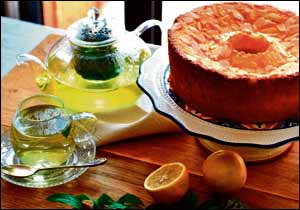| FOOD | |
| An Italian flavour to my childhood | |
ONE of my favourite times on a recent trip to the Italian Riviera was our visit to Genoa.
Genoa is an ancient port city, home to a colourful outdoor food market that is simply a paradise for foodies. We spent hours wandering around, taking in the sounds, aromas, vibrant colours and fascinating assortment of foods and products. In the caruggi (narrow streets) of Genoa’s old town, we came across many family-run restaurants that served Italian dishes of fish and pasta, which were prepared with local produce. We were served hot, crispy focaccia with a unique pesto spread like nothing I’ve ever tasted. In addition, we tasted bread that I’d never come across before: farinata, which is made from chickpea flour. At a small bakery, with gorgeous pastries and delicacies on view behind the display window, I saw a cake that looked so similar to something my mother used to bake for us on Rosh Hashana. I went to investigate at close quarters. Yes — it had raisins and other dried fruits inside just like I remembered from my childhood. And it smelled similar, too. I remembered it being called Bolo, but here it was referred to as Pandolce Genovese, and apparently, it was a popular Christmas treat. At that moment, I realised that a number of my favourite dishes from my childhood were actually Italian. During my stay in Italy, I continued to find more dishes that I recognised from home, such as a lemon-almond tart, pizza with sardines and black olives, and galleta, which are thin salty crackers my mother used to serve for kiddush on Shabbat morning. It was not easy, but I managed to convince a few bakers to give me their secret recipes for these special dishes that demonstrate the awesome connection Italy and Tunisia share.
Almond Lemon Tart MY mother’s version of this tart called for oil instead of butter, probably so we could eat it after meat meals. Ingredients
Toppings:
METHOD Add the egg whites to the bowl of an electric mixer and whip on high speed. Gradually add the sugar and vanilla sugar while mixing and mix until stiff peaks form. Gradually add the egg yolks. Mix until colour is uniform. Gently fold in the lemon zest and gradually fold in the flour, almond flour, butter or oil, and lemon juice. Mix well. Pour batter into a pan that has been greased well. Sprinkle with almond slivers and bake in an oven that has been preheated to 180°C for 35-40 minutes or until a toothpick comes out dry. Remove from the oven and let cool. Sprinkle with powdered sugar.
Pandolce Genovese SOME sources say this sweet bread was first concocted during a competition in which bakers had to come up with a new recipe for a cake that would last for many days and so could be taken on long sea voyages. Ingredients
METHOD Place the butter in the bowl of an electric mixer fitted with a dough hook. Gradually add the sugar and the vanilla sugar. Mix until smooth and creamy. Add the egg and mix on medium speed until well mixed. In a pot, heat the milk or other liquid with yellow food colouring and citrus concentrate. The liquid should be warm — about 40°C. If it’s too hot when you add it to the batter, the dough will come out too soft. If the liquid is too cold, the batter will be too hard. Add the warmed liquid to the batter and mix. Keep mixing while you add the flour, baking powder, coriander, fennel seeds, lemon and orange zest. Mix for three minutes and then add the pine nuts, raisins, and candied fruits. Mix for another two to three minutes until smooth. Generously flour a work surface and then knead dough well. Form a long roll and cut it into three equal sections. Roll each section into round rolls. Alternatively, you could make one large loaf. Make sure none of the raisins or fruit pieces is sticking out of the dough too much, since they will burn. Line a pan with baking paper and place the pandolce on the tray with at least five centimetres between each one. Flatten them a little with your hands and take a knife and make indentations on top (triangle, X, lines, or a square). Bake in an oven that has been preheated to 200-210°C for 35-40 minutes or until a toothpick inserted in the middle comes out dry. Let cool completely before serving. This cake is even tastier after a day or two.
If you have a story or an issue you want us to cover, let us know - in complete confidence - by contacting newsdesk@jewishtelegraph.com, 0161-741 2631 or via Facebook / Twitter
|
